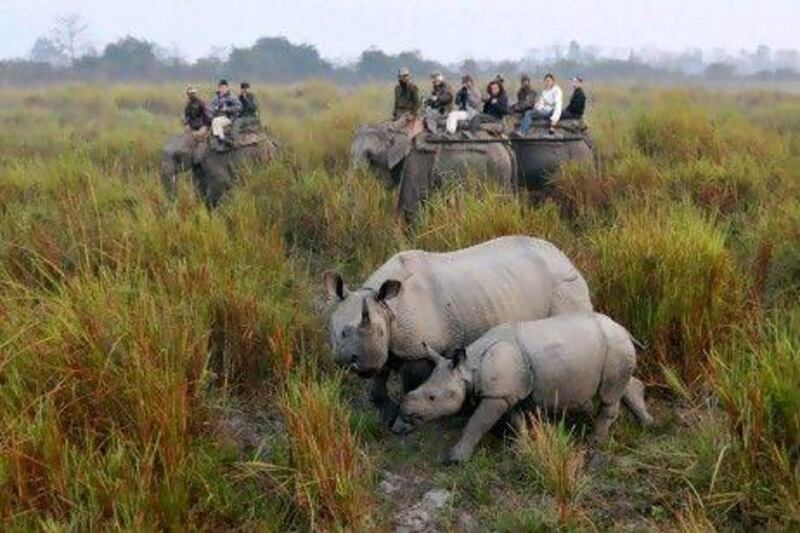NEW DELHI // Flash floods in the north-east state of Assam have killed more than 120 people and claimed other victims - nearly 600 animals at Kaziranga National Park, a Unesco World Heritage Site.
The casualties include 17 one-horned rhinoceroses, listed by the International Union for Conservation of Nature (IUCN) as a vulnerable species.
The monsoon floods, which began on June 22, have swollen the Brahmaputra river and its tributaries, forcing about 500,000 people into relief camps and cutting road and rail links in many places.
Kaziranga, a 430-square-kilometre swathe of forests and marshland, is bordered to its north and east by the Brahmaputra, so it often bears the brunt of its flooding. Floods in 1988 killed more than 1,000 animals, while another 652 died in flooding in 1992.
A statement from the ministry of environment and forests, issued on Monday, said that 595 animal carcasses had been found.
These included 512 hog deer - native to India, Pakistan and south-east Asia - two elephants and 10 swamp deer.
"During normal floods, which are [a] recurring feature, there is less mortality of wild animals," the statement said. "However, flash floods do occur due to breaches in the upper areas of Brahmaputra, which result in increased deaths of wild animals."
A team of officials and conservation experts has been sent from New Delhi to review the situation in Kaziranga, even as the waters of the Brahmaputra have started to recede.
"The water is now much below the danger level, although we will maintain our monsoon management strategies until the end of October," D D Gogoi, the divisional forest officer at Kaziranga, told The National.
"It is unfortunate that so many hog deer have been victims this year, but the flood is a regular phenomenon, and integral to the Kaziranga ecosystem."
Given the total population of the various species in the park, Mr Gogoi said their viability has not been threatened.
M Firoz Ahmed, a wildlife biologist with Aaranyak, a biodiversity non-profit based in Guwahati, Assam's capital, told The National that during such floods, animals stream out of the forest to higher and drier land.
"The highlands within the park give animals some safety," Mr Ahmed said. "It is usually the young and the old or diseased animals that die in such floods, because they cannot swim or get on to higher land.
"So these deaths are harmful from our perspective, but not necessarily from nature's perspective."
Mr Gogoi confirmed that, of the 17 rhinos that had died, two had been calves while the remaining had been older animals.
The flood also forced the abandonment of 16 of Kaziranga's anti-poaching camps, which are staffed by personnel who patrol the park and track poaching activity. The abandonment of these camps can give poachers easier access to animals as they emerge from the forests and seek higher terrain.
Three of the 17 rhinos found dead were victims of poaching.
"Around 50 or 100 rhinos come out of the park during such floods, although they stay close to the park's borders," Mr Ahmed said. "The immediate danger now is poachers who will try to get to the rhinos. But the communities around the park are helping. They want to protect these animals, which is a good sign."
"We have sent guards back to the 16 anti-poaching camps that we had to abandon," Mr Gogoi said. "We are keeping a high alert around the clock."
The rhinoceros unicornis - a powerful, stocky animal that is often poached for its horn - was behind the creation of Kaziranga.
In the early 20th century, when the wife of Lord Curzon, the British viceroy at the time, failed to spot a single rhino, she convinced her husband to protect the animal.
In 1905, Kaziranga was opened as a "reserved forest", and it has helped preservation. A 1999 census found roughly 1,700 rhinos in Kaziranga, while a census in April this year counted 2,290 out of a world population of 3,300.
The concentration of the species in Kaziranga has often been a cause for concern. The rhino's populations are "severely fragmented, and with more than 70 per cent of the population in Kaziranga National Park, a catastrophic event there could have a devastating impact on the status of the species," IUCN has stated in its entry for the rhino.
Kaziranga is also home to more than 110 royal Bengal tigers, 1,165 Asiatic elephants and more than 500 species of birds.
[ ssubramanian@thenational.ae ]
Follow
The National
on
[ @TheNationalUAE ]
& Samanth Subramanian on
[ @Samanth_S ]





